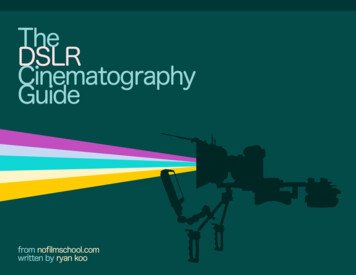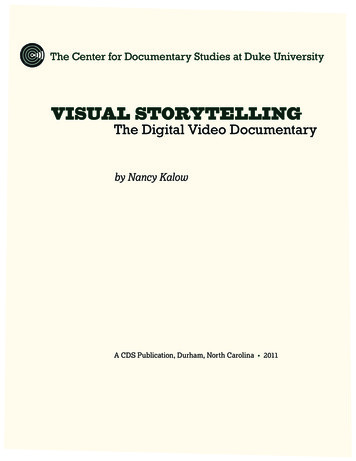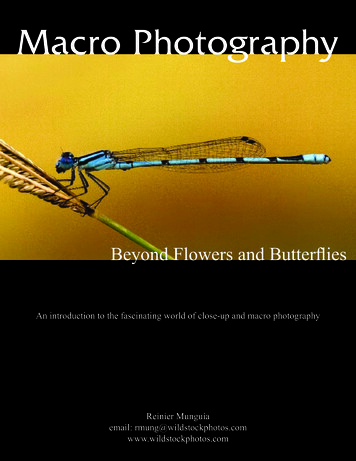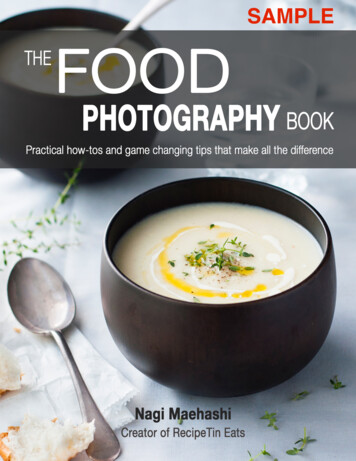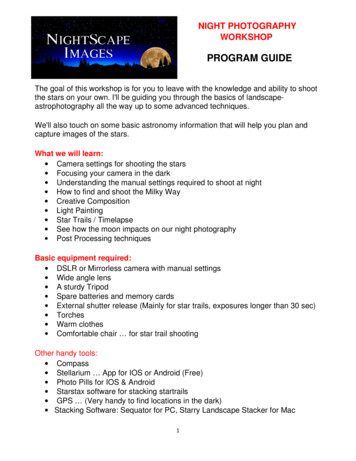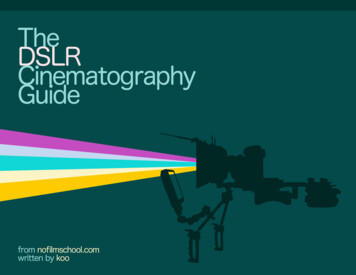
Transcription
2The latest version of this guide can always be found athttp://nofilmschool.com/dslr2010, KooThis document is licensed under Creative Commons, so the following freedoms apply. However, I would request you do not email this PDF to a friend; instead,please send them to http://nofilmschool.com/dslr where they can get their own copy of the guide for free. Thanks very much.You are free:to Share — to copy, distribute and transmit the workto Remix — to adapt the workUnder the following conditions:Attribution — You must attribute the work in the manner specified by the author or licensor (but not in any way that suggests that they endorseyou or your use of the work).Noncommercial — You may not use this work for commercial purposes.Share Alike — If you alter, transform, or build upon this work, you may distribute the resulting work only under the same or similar license to thisone.You can find out more about this license at: s/nofilmschool.com/dslr
3Most people would charge good money for this guide, but I’m giving it away free. In return, I ask that you please help support NoFilmSchool! You can do thisvia the following:Share the guideIf you have a blog or website, please write a post telling others about NoFilmSchool (and the DSLR Guide)! If you don’t have a website, please shareNoFilmSchool via Facebook, Twitter, or any other social network. Also, be sure to friend us on:FacebookTwitterVimeoGet your gear from the links in this guideThis guide includes a number of affiliate links, which means I get a small percentage of anything you buy via those links. This percentage comes out of thestore’s cut, not yours — items won’t cost you a penny more. In fact, if you want to support NoFilmSchool at no cost, one of the easiest ways to do so is to buyanything from either of the following stores (just click on the links below):You can find out more about affiliate links — and more ways to support NoFilmSchool — by going to http://nofilmschool.com/supportDonate!Affiliate links are a great way of getting some value out of the guide while keeping it free, but they really only pay pennies on the dollar. If you find the guideas helpful as I hope you will, please consider donating! There are some sections of the guide that I’ve written because of popular demand — despite the factthat I don’t even own the featured equipment, because I haven’t been able to afford it. I’m extremely grateful for any donation, large or small. You can donateby going to http://nofilmschool.com/supportFor those of you who have donated in the past, thank you so much for your support — now, onto the guide!nofilmschool.com/dslr
4TABLE OF CONTENTSChapter 01Chapter 02Chapter 03Chapter 04Chapter 05Chapter 06Chapter 07Chapter 08Chapter 09Chapter 10Chapter 11Chapter 12Chapter 13Chapter 14IntroductionBasic Cinematography ConceptsChoosing A DSLRSaving MoneyStuck PixelsAliasing And MoiréRolling ShutterOverheatingLenses: Using Primes, Choosing A BrandLenses: Adapting, PurchasingLenses: Focal Lengths, Depth Of FieldLenses: Renting, ConvertingStorage (For The Shoot)Support /dslr
5Chapter 15Chapter 16Chapter 17Chapter 18Chapter 19Chapter 20Chapter 21Chapter 22Chapter 23Chapter 24Chapter 25Chapter 26Chapter 27Chapter 28Chapter 29Chapter 30PowerAudioMagic Lantern FirmwareGH1 FirmwareMatte BoxFiltration, Variable NDLCD ViewfinderField MonitorPicture Style EditorPost-Production OverviewStorage (For The Edit)Transferring, Viewing, TranscodingAudio Sync, DriftNoise ReductionColor GradingThanks For school.com/dslr
6INTRODUCTIONWhy are DSLRs soimportant?That “movie mode” hidden in the menu system of your new DSLR? It’s not just a noveltyfeature. Together with the emergence of large CMOS imagers, HDSLRs are nothing shortof a revolutionary, democratizing, disruptive moviemaking technology, as important as theinvention of color film, 16mm, or HDTV. Not convinced? I’ve written more about how theDSLR is affecting the future of not only cinematography but also photography, as well as howtheir low-light sensitivity enables a whole new generation of international filmmakers to telltheir story. However, the proof is in the pudding, so here are ten examples of stunning DSLRcinematography. Zacuto’s Great Camera Shootout 2010 is another great demonstration ofwhat DSLRs are capable of when compared to (much more expensive) 35mm film cameras.nofilmschool.com/dslr
7As for my own DSLR qualifications, I recently shot two episodes of the WBP Labs/Babelgum show RADAR on a Nikon D90; several behind-the-scenes videos for FocusFeatures on a Canon 5d Mark II; some other DSLR footage I can’t yet talk about publicly;and I’ve lensed plenty of pre-DSLR projects (e.g. The West Side, or a music video I shotwhen I was 19).DSLRs are agreat enableron the “no filmschool” front.Digital cinematography ischanging so rapidly these daysthat a printed book on thesubject will likely be outdatedby the time it reaches storeshelves; this is especially truewhen it comes to the rapidrelease cycle of DSLRs. Up-todate information can be foundon online forums, but forumslack the organizing principlesof a book, and as a result itcan take a ludicrously long time to piece together reliable information (I spent monthsforum-surfing to assemble my own camera package). Thus, this guide: I hope it savesreaders money they would’ve otherwise spent on an out-of-date book, and I hope itsaves forums from so many newbie — sorry, “n00b” — questions.DSLRs (often called HDSLRs or VDSLRs now) are a great enabler on the “no film school”front, as they are priced to own and allow aspiring filmmakers to follow the “buy anofilmschool.com/dslr
8camera and learn” lesson plan. But as with any creative tool, a DSLR is only as goodas the person using it — because, while these cameras offer a world of advantages,they also come with a considerable set of drawbacks. However, these drawbacks areworth dealing with in order to get the kind of amazing images possible with an imagingsensor that has twenty to thirty times more surface area than that of a similarly priced,dedicated video camera. To emphasize: these cameras are not designed to shootmovies. Their primary function remains to shoot still photos, but it just so happens thatthey shoot amazing video very inexpensively, and for that they are worth tinkeringwith, hacking, and jumping through a number of hoops to use. And make no mistake: tomodify these still cameras to behave like “real” movie cameras, there are a lot of hoopsto jump through (thus the length of this guide), but you will be rewarded by using acamera that many of us could only dream of a few years ago, for cheaper than any of usimagined.As with anycreative tool,a DSLR is onlyas good as theperson using it.This guide assumes some basic knowledge of moving images, such as exposure, shutterspeed, focal length, and frame rate. It focuses on the technical challenges uniqueto DSLR cinematography — it won’t teach you how to light scenes, stage cameramovements, or cook a full English breakfast. It will, however, give you a huge jump startin figuring out how to make beautiful, inexpensive movies using a DSLR.I can only take credit for a small percentage of the knowledge here. The vast majorityof it comes from terrific user forums like DV Info, Cinema5d, DVXuser, REDuser, andCreative COW; news sites like FreshDV and Pro Video Coalition; and noted DSLR userslike Philip Bloom, Dan Chung, Vincent LaForet, Jon Fairhurst, Stu Maschwitz, and ShaneHurlbut (not to mention firmware luminary Tramm Hudson). I’ve tried to credit andnofilmschool.com/dslr
9link to others wherever possible, but ultimately this is one person’s opinion. I’ve takena lot of findings from the forums and aforementioned users, combined them with myown experiences, and distilled everything down into one time-saving guide. Plenty ofpeople will disagree with some of what I say here, so please make the forums your firststop after reading this guide. Let me repeat: if you have questions, take them to theforums — you’ll get a faster response and benefit from the wisdom of the crowd. Finally,take into account the crucial fact that this guide is free! It’s saving a lot of people a lotof time, and it costs nothing, so with that in mind, please keep your comments andsuggestions constructive.The guide is organized in order of basic-to-advanced, meaning you can read it fromstart to finish if you’re new to DSLR cinematography, or jump around using the table ofcontents if you’re a seasoned vet. Without further ado, let’s get started!nofilmschool.com/dslr
10BASICCINEMATOGRAPHYCONCEPTSWhat should I know about(digital) cinematography?From reader emails, I realized that a basic introduction to some of the concepts referencedlater in the guide might be helpful. Many of you are already familiar with these terms,so feel free to skip this chapter! However, if your background is in still photography or ifyou’re new to digital imaging in general, this bonus chapter should help clarify some basiccinematography concepts that we’ll be working with going forward. By no means is this anexhaustive glossary, but it is a good starting point. I’m going to explain things from a practical,crash-course standpoint rather than a scientific, 100% semantically-correct perspective,because I think it’s handier to know how something works in practice than it is to know all ofthe details of why it works — if you’re looking for knowledge of the latter, there are of coursenofilmschool.com/dslr
11thousands of good resources on the internet to bolster your knowledge. In alphabeticalorder, then, here are ten basic concepts you should be familiar with:1. Aspect Ratios & Anamorphic LensesAspect Ratio used to be a more prominent issue for digital cinematographers than itis today: before the advent of high-definition cameras, the standard 4:3 aspect ratioof standard-definition TV was generally seen as undesirable for anyone looking for a“cinematic” look, because 4:3 (or 1.33:1) content was associated with broadcast TV,while widescreen compositions were what people expected to see in the theater. Whenwe say “4:3,” we mean the image is four units wide and three units high. When we“1.33:1,” we mean well, you get it — the same thing. Many times the “:1” is removedbecause it is implied – shooters will simply say “1.85” instead of “1.85:1.”nofilmschool.com/dslr
12HDTV today is widescreen bydefault, with a 16:9 aspect ratiothat works out to be 1.78:1 — verysimilar to the traditional 1.85:1aspect ratio of many feature films.Other than these two virtuallyindistinguishable aspect ratios, themost common widescreen aspectis the CinemaScope ratio of 2.35:1,which appears most often in themultiplex in big-budget films.2.35:1 films are typically shot withanamorphic cine lenses. Anamorphic lenses are not spherical in the sense that theysqueeze an image to fill the negative or sensor, with an additional step necessary duringprojection to re-stretch the image to the intended size. The odd-looking image here ofa lens with an oval aperture demonstrates the non-spherical nature of an anamorphiclens (the aperture is perfectly round, but the lens is distorting our view of it). While itis possible to attach an anamorphic lens to a DSLR, most of us will simply shoot at thenative widescreen aspect ratio of 16:9.2. BokehBokeh (pronounced like “bo” from “boat” and “ke” from “Kentucky”) is one of thechief reasons many shooters have switched to DSLRs. Bokeh is a term derived fromnofilmschool.com/dslr
13the Japanese word“boke” which, roughlytranslated, means “blurquality.” Bokeh refers tothe portions of an imagethat are defocused orblurry. In the filmmaker’stoolkit, bokeh is not onlyan aesthetically pleasingquality, but it also allowsthe filmmaker to focus theviewer’s eye on an objector area of interest in theframe. Bokeh is a function of shallow depth-of-field (see below).3. Compression & Bit RateLossy codecsare the reasonwe can recordhours of footageto inexpensiveflash memorydevices like CFand SD cards.Compression refers to a method for reducing the amount of data a DSLR produces;in the case of video-shooting DSLRs, all cameras currently employ some method ofcompression. If you’re used to shooting photos in JPEG format, you’re used to capturingcompressed images; while RAW can also employ compression, it is generally thoughtof as “uncompressed.” This is because, as far as shooters are concerned, when we’retalking about compression we’re talking about lossy compression — meaning, a codec(compression algorithm) that throws out data in order to reduce file size. As you canimagine, tossing portions of an image has negative side effects, and while many codecsnofilmschool.com/dslr
14DSLRs explodedin popularityalmostsinglehandedlybecause of theirability to renderimages with ashallow depthof field.deal with images perceptually in orderto minimize their perceived impact, thedifference is there. For example, if youupload a video to YouTube, the service recompresses your video in order to optimizeit for internet delivery; you might not noticethis compression, but check out this videothat’s been recompressed a thousand timesand you can see that every compressionstep throws out data along the way. On thepositive side, however, lossy codecs are also the reason we can record hours of footageto inexpensive flash memory devices like CF and SD cards.The most common compression formats in DSLRs are h.264 and MJPEG, and while bothare lossy, h.264 is generally much more efficient (it introduces less artifacts at the samebit rate as MPJEG). Bit rate is the amount of data per time that a given codec adheresto; higher bit rates are almost always better because they use less compression. At presstime there are no DSLRs that shoot uncompressed video.4. Depth of FieldThe amount to which objects in the foreground, mid-ground and background are allin focus at once is a function of depth of field. A shallow depth of field would meanthat only one plane was in focus; a wide (or deep) depth of field would mean thatall planes are in focus at once. Depth of field is determined by the focal distance andnofilmschool.com/dslr
15aperture size (see below formore on Aperture). DSLRsexploded in popularity almostsinglehandedly because oftheir ability to render imageswith a shallow depth of field.This is chiefly due to theirmassive sensor sizes (seethe next chapter, “Choosinga DSLR,” for an examinationof sensor sizes), which areexponentially larger thanprevious video cameras. On a basic level, shallow depth of field (DOF) allows filmmakersto blur out areas of the image they deem to be unimportant or undesired.5. Exposure & ApertureIn video mode,DSLRs usean electronicshutter.Exposure refers to the amount of light allowed to enter the DSLR sensor (or any imagingsurface). When shooting stills, DSLRs use a mechanical shutter to regulate exposure byopening for the desired amount of time (1/60th or 1/1000th of a second, for example)and then closing. DSLRs are generally rated to last for hundreds of thousands of shuttercycles, but at 24 frames per second, couldn’t your DSLR reach that limit very quickly? No,because in video mode, DSLRs use an electronic shutter — the sensor basically turns onand off to regulate exposure, instead of relying on a physical barrier (i.e., the mechanicalshutter) to regulate light. Aperture refers to the adjustable opening near the rear ofnofilmschool.com/dslr
16the lens that lets light through —the amount of light it transmits isgenerally referred to as the F-stop(T-stop is very similar, except it’smeasured instead of calculated).We’ll go more into depth onaperture in the “Lenses” sectionof the guide, but keep in mind thatthe size of the aperture does notonly affect the amount of light, butalso the angle of light rays hittingthe sensor — a narrow aperturecreates an image with a wide depth of field, whereas a large aperture creates an imagewith a shallower depth of field.A narrowaperture createsan image witha wide depth offield, whereas alarge aperturecreates animage with ashallower depthof field.6. Focal LengthTechnically, focal length refers to the distance over which collimated rays are broughtinto focus. An easier way to think of it: focal length refers to image magnification. Alonger focal length, e.g. 100mm, makes distant objects appear larger, whereas thosesame objects will appear smaller with a shorter focal length, e.g. 35mm. Focal lengthalso refers to angle of view; longer focal lengths have a narrower angle of view, whereasshorter focal lengths have a broader angle of view. When it comes to focal length, apicture is worth a thousand words, so here are images taken with the camera in thesame place, but with lenses of different focal lengths attached:nofilmschool.com/dslr
1728mmBeing able toshoot in 24pis essential ifyou’re planningon shootingnarrativematerial.70mm50mm210mm7. Frame RateFrame rate is the frequency with which your DSLR captures consecutive images. Thistypically corresponds to the number right before a “P” in the case of progressive images,nofilmschool.com/dslr
18so that 24p is 24 frames per second, 30p is 30 frames per second, and 60p is 6,000,000frames per second. Just kidding. Different frame rates have very different motionrendering characteristics, which, combined with different shutter speeds, produceimages that behave very differently. Motion pictures have had a standard frame rate of24 frames per second since the 1920s, and audiences have come to associate this framerate with cinematic content, so being able to shoot in 24p is essential if you’re planningon shooting narrative material. However, you don’t always have to shoot at the sameframe rate at which you’re planning on distributing your material. For example, if yourDSLR can shoot 60p, this is a very effective way of acquiring slow-motion footage —anything shot at 60p can be played back at 40% speed in a 24p timeline for a flawlessslow-motion effect, and can generally be slowed down further in your editing system.8. ISO & NoiseISO is alogarithmicmeasurement,so ISO 800is twice assensitive to lightas ISO 400, ISO400 is twice assensitive as ISO200, and so onand so forth.ISO is actually the International Organization for Standardization, which is why you seeit used in lots of places beyond photography — many businesses are certified ISO:9001,for example. As cinematographers we’re concerned with just one “standardization,”however — the one that pertains to measurement of noise in photography. ISO as itrelates to digital photography is based on analog standards of film speed — while wewon’t be shooting a frame of actual film with our DSLRs, our cameras are calibrated sothat an ISO of 400 on our camera is somewhat equivalent to a film SLR’s ISO 400. ISO is alogarithmic measurement, so ISO 400 is twice as sensitive to light as ISO 200, ISO 200 istwice as sensitive as ISO 100, and so on and so forth.The relationships between sensitivity and noise is basically linear, however, so thenofilmschool.com/dslr
19higher the ISO, the brighter the image — and the more noise contained in the image.However, thanks to sophisticated noise reduction and other processing tricks, DSLRshave managed to dramatically reduce noise at higher ISOs, and can often blow film stockout of the water (this depends on which camera you’re shooting with, which we’ll coverin the next chapter).9. Progressive vs. InterlacedInterlacing cancause motionartifacts as wellas a host ofother problems.Interlacing was a workaround invented for oldertech CRT monitors in the 1930s that has lived far toolong. In the early days, video bandwidth was morelimited than today, and so engineers found a way todivide a frame into two images and display it usingalternating fields. As you can see in this image of atire wheel, interlacing can cause motion artifacts (aswell as a host of other problems). We’re lucky to livein a predominantly progressive society today — inthe imaging sense if not the political. Progressive scanning is a method that capturesand displays the lines of an image in sequence, which is akin to motion picture film withregards to motion rendering. Compared to interlaced images, progressive images havea higher vertical resolution, lower incidence of artifacts, and scale better (both spatiallyand temporally). Friends don’t let friends shoot interlaced! Luckily, while there areplenty of video cameras that shoot interlaced footage, every DSLR I can think of shootsprogressive footage.nofilmschool.com/dslr
2010. Shutter SpeedShutter speed refers to the length of time an image is exposed. For film SLRs, this wouldbe measured by the amount of time the camera’s mechanical shutter is open, but forshooting video on DSLRs, this is simulated electronically. Shutter speed affects the amountof light that reaches the camera and also affects the motion rendering of the movingShutter speedaffects theamount of lightthat reachesthe camera andalso affectsthe motionrendering of themoving image.nofilmschool.com/dslr
21image. Lower shutter speeds yield a brighter and smoother image (up to and includingwater and light blurring tricks), whereas higher shutter speeds result in a darker and morestroboscopic image.Motion picture film cameras typically shoot with a 180-degree shutter, which means thatthe shutter is open 50% of the time (180 out of 360 degrees). This means the amount oftime your shutter is open is half of the shooting frame rate; thus, at 24 frames per second,a 180-degree shutter is best emulated on a DSLR by choosing a shutter speed of 1/48.This may not be possible depending on your DSLR, so the closest reading will do — 1/50or 1/60, for example. This gives the most “filmic” rendering of motion, but can be variedgreatly depending on your intention. Higher shutter speeds create “jerkier” images, asmost famously seen in action films like Saving Private Ryan and Gladiator. Conversely,lower shutter speeds create “smoother” images due to increased motion blur. There is nohard and fast rule when it comes to shutter speed, but if you’re not sure of what shutterspeed to select, go with the setting that’s closest to half that of your current frame rate.Okay! That was much longer chapter than I anticipated, despite blitzing through theseconcepts as quickly as possible. If you don’t understand something, don’t worry – you’llfigure it out as you go. Now let’s get started with DSLRs by checking out some cameras.nofilmschool.com/dslr
22CHOOSING ADSLRWhich camera is rightfor me?This guide focuses on Canon’s EOS series of DSLRs (1D Mark IV, 5D Mark II, 7D, 60D, Rebel T1i,Rebel T2i), but also pertains to Nikon’s cameras (D3100, D90, D300s, D3s), as well as othervideo-capable DSLRs like the Panasonic Lumix GH1, Pentax K-7 HD, and Sony’s A55, A33, andNEX series. Given new cameras are always hitting the market, you might want to check outthe top-selling DSLRs list to find out what’s current. If you’re wondering why some DSLRsshoot video and others don’t — or why none of them did a couple years ago — check outGizmodo’s article. At this point in time I believe the Canon DSLRs offer the best quality andflexibility for filmmakers, due in part to their superior h.264-based codec (which is of higherquality than the MJPEG codecs of Nikon and the lower-bitrate AVCHD codec of Panasonic’soffering). However there are several top DSLRs contending for your hard-earned dollars (notnofilmschool.com/dslr/camera
23all Canons); each camera has its particular strengths and weaknesses, which should helpyou decide which DSLR is right for your particular needs.The main thing to understand while reading the following comparison is how DSLRsensor size affects the images the camera produces. Larger sensors aren’t always better,but for our purposes it’s easiest to think of larger sensors as capturing images that havea shallower depth of field, greater dynamic range, and better low-light sensitivity. Here isa chart of DSLR sensor size: 1As you can see in the chart, Canonand Nikon’s implementation ofAPS-C is slightly different, butnot enough to make a practicaldifference. For comparison’s sake,I’ve included the 9,000 Sony EX-3professional video camera in thechart — you can see how muchlarger all of these DSLR sensors are,which is the chief reason why DSLRsare such a disruptive technology.With this in mind, let’s take a lookat the top DSLRs for filmmaking:1Sensor size illustration modified from a Wikipedia image by Moxfyre and Autopilot.nofilmschool.com/dslr/camera
24Canon 5D Mark IIStrengths: In my opinion, thanks to its full framesensor the 5D produces the smoothest, mostbeautiful images of them all (this should be writtenout four times because this factor far outweighsthe others ) Also due to the sensor size, the 5D isthe friendliest of the Canon DSLRs for using old SLRlenses (you don’t have to deal with crop factors).Thanks to a firmware update, shoots at 1080p/24pas well as 30p. Also has manual 48KHz audio. Goodbuild quality. Shoots terrific stills.One importantissue regardingyour DSLRchoice that youwon’t find ina manual orspec sheet isthe camera’shackability.Weaknesses: HDMI output drops to 480p the moment you hit record; this is terrible forusing field monitors (not so much an issue if you’re planning on using a LCD viewfinder).Footage starts to get noisy from heat without the camera telling you it’s overheating.Full frame sensor can be an issue if you want to adapt cine lenses, which don’t coverthe almost VistaVision-sized sensor. No 50p or 60p which means you can’t get greatslow-motion footage from the camera. Full frame sensor means your depth of field is soshallow that it can be difficult to pull focus.Canon T2i (a.k.a 550D)Strengths: A great deal — it’s basically the same camera as the 7D (see below) for lessnofilmschool.com/dslr/camera
25than half the price. Cinema-sized APS-C sensor sizewith lots of recording options: at 1080p, 24p/25p/30p;at 720p, 50p/60p (great for slow-mo work). TerrificLCD screen. Did I mention the T2i is a great deal? IMOit can’t be beat as a “first DSLR.”Weaknesses: Not much weather coating, and not asgood at shooting stills as some of the others (slowercontinuous shooting speed, no top LCD). HDMI-outdrops to 480p during recording. Overheats easily. Nomanual audio control and no manual white balancing.Canon 7DStrengths: Offers some advantages over its cheapercousin T2i, chiefly that its HDMI-out stays at 1080iduring recording. If you’re planning on using afield monitor, this is huge. The 7D is also crazilyweatherproofed — video camera users will not beused to being able to leave a camera recording in rainand snow, but the 7D can handle adverse conditionswith aplomb; something to keep in mind if you’reshooting in extreme conditions. Same sensor size andflexible video recording options as the T2i.nofilmschool.com/dslr/camera
26Weaknesses: More expensive than the T2i without offering a ton of upgraded features –it’s still priced very aggressively, and its price wouldn’t be considered a “weakness” if itweren’t for the cheapness of the T2i. Overheats easily. No manual audio control.Canon 1D Mark IVStrengths: Canon engineers applied some magicto the sensor and got some extra low-lightperformance out of the sensor (most famouslydemonstrated by Nocturne). APS-H sensorsize splits the difference between Full Frameand APS-C, which can offer some interestingadvantages (zoom lenses get a bit more reach andyour lens kit effectively doubles if you’re pairingthe 1D with a different camera because primesattain a different focal length on the 1D). Beefierbatteries, beefier build quality.Weaknesses: APS-H sensor splits the difference between Full Frame and APS-C, whichcan offer some interesting disadvantages (good luck finding good wide-angle lenses). Nomanual audio. More than twice as expensive as the 5D Mark II, yet has a smaller sensor.Nikon D3sStrengths: Full frame sensor just like the 5DmkII; the best low-light performer of themnofilmschool.com/dslr/camera
27all thanks to A) the size of the sensor, B) largerpixels on the same size sensor (the D3s is 12MPinstead of 21MP), and C) better noise reduction. Ifyou’ve got a lot of Nikon lenses, you don’t need tomess with adapters. Probably the best camera inthis roundup for taking still photos.Weaknesses: Maxes out at 720p! Crappy recordingcodec. 5-minute clip limit (Canons max out at12 minute takes). Nikon engineers are still significantly behind Canon engineers whenit comes to video and so the 5k Nikon DSLR trails the 800 Canon when it comes toresolution, codec, and frame rate options. No manual audio control.Panasonic GH1Strengths: Inexpensive. Offers 1080p at 24p and720p at 60p (for North America; 25p and 50p forPAL countries). Articulating LCD screen and actuallyviable auto focus give shooters greater flexibility thanthe other DSLRs here. The GH1 also doesn’t lineskip like the Canons do which reduces or eliminatesaliasing problems. I didn’t consider the GH1 to be aparticularly viable camera for filmmaking because ofits codec, until it was significantly upgraded thanksto a brilliant hacked firmware that allows the codec bitrate to be raised from 17Mbitnofilmschool.com/dslr/camera
28to 50Mbit. For more on this firmware, see the chapter “GH1 Firmware.” At such ahigh datarate the efficiency of the codec is much less of an issue; this singlehandedlytransforms the GH1 into a viable moviemaking tool. DVXUser has some GH1/5Dcomparisons, from which users seem to favor the GH1’s image.Weaknesses: Low-bitrate codec is crippling if you’re not into the idea of installingunsupported hacked firmware on your 1k equipment. Not great in low light no matterwhat you do to the firmware. Micro 4/3 sensor won’t give you as shallow a DOF as therest of the cameras here. No manual audio options.Wh
DSLR is affecting the future of not only cinematography but also photography, as well as how their low-light sensitivity enables a whole new generation of international filmmakers to tell their story. However, the proof is in the pudding, so here are ten e
